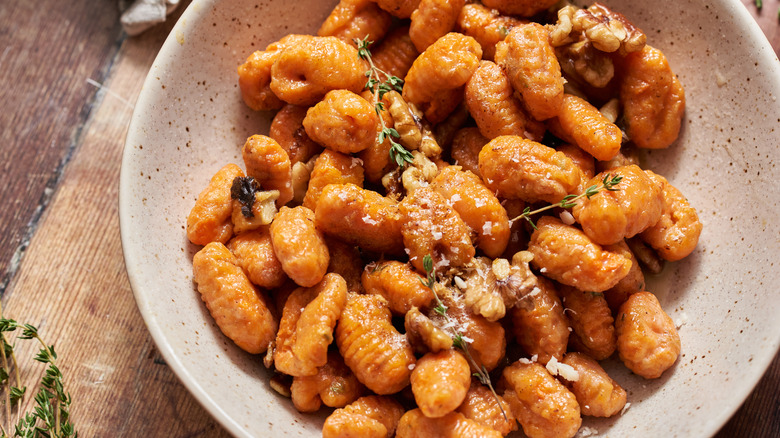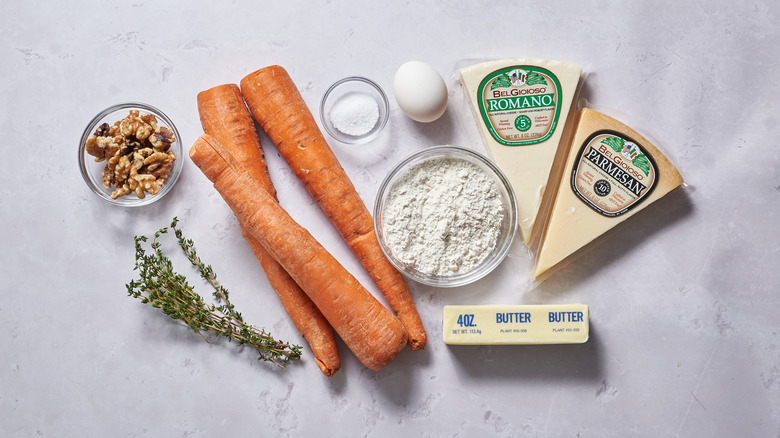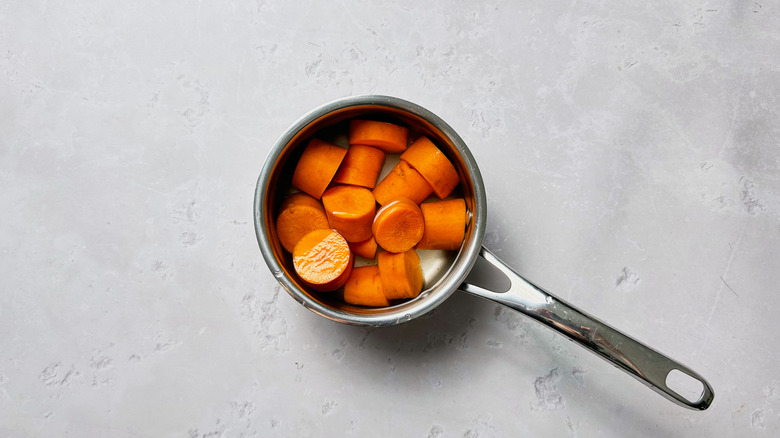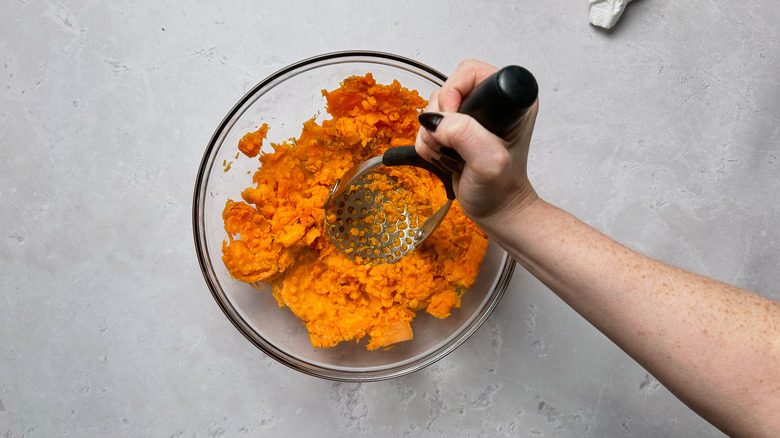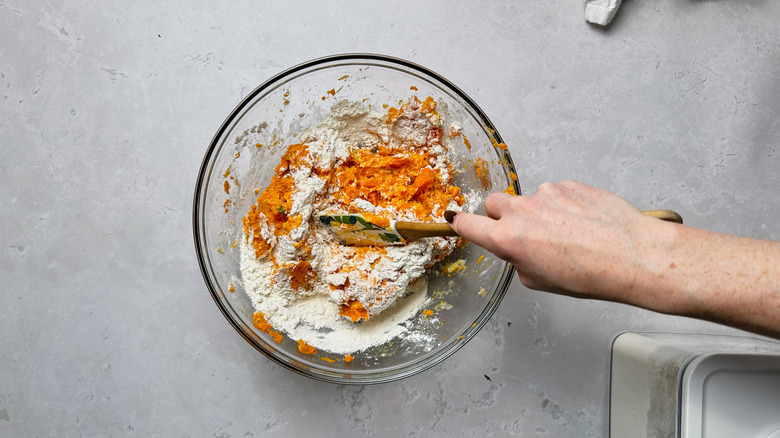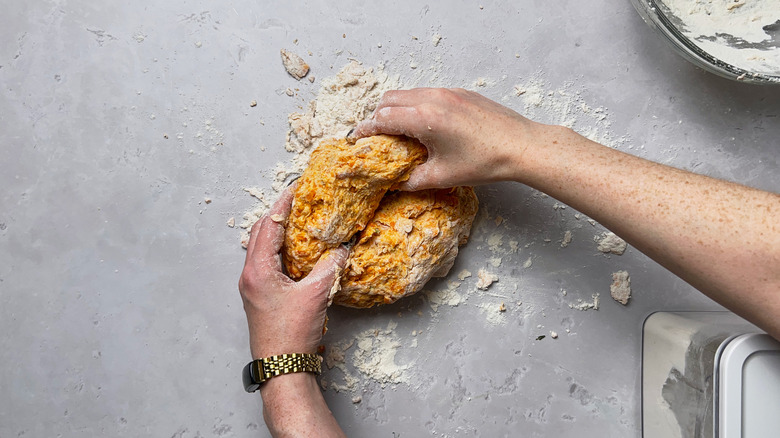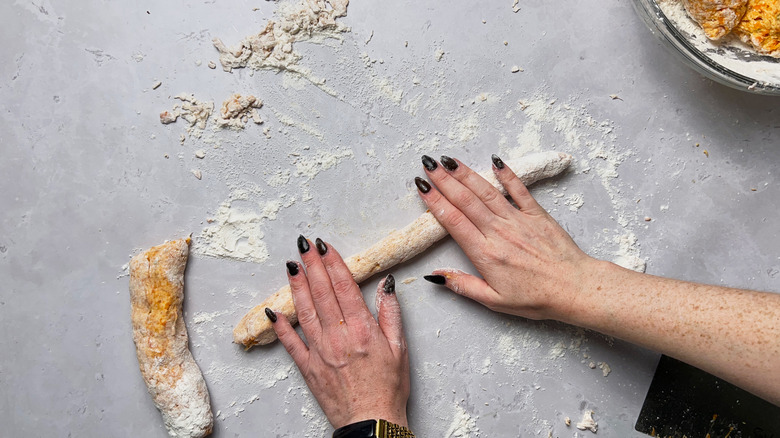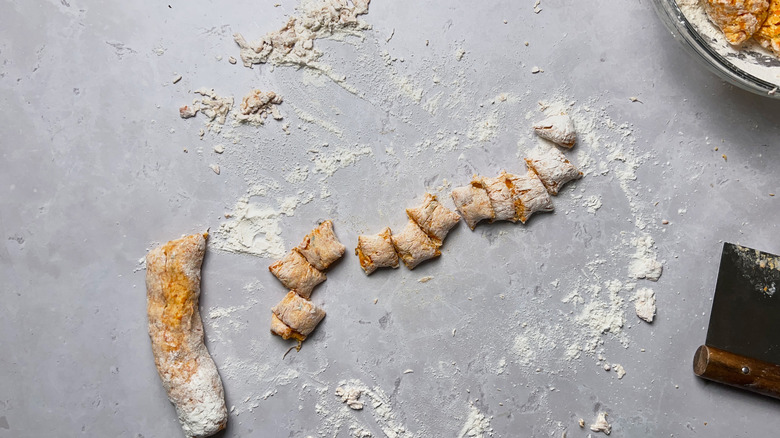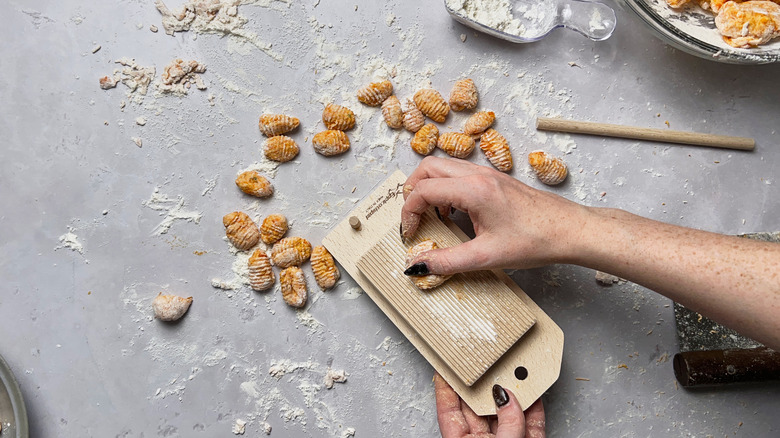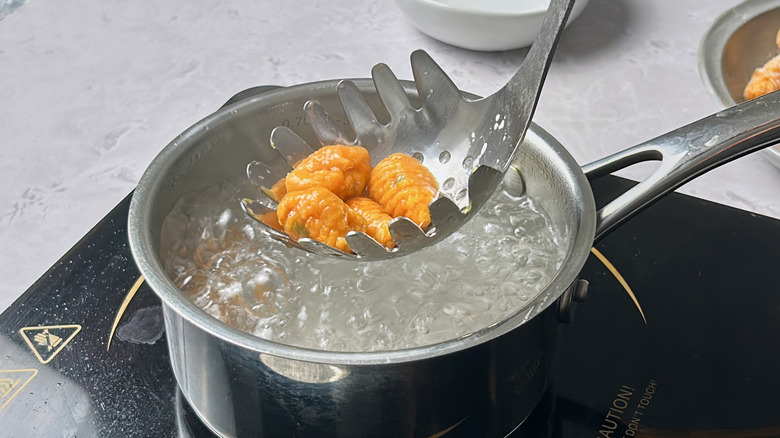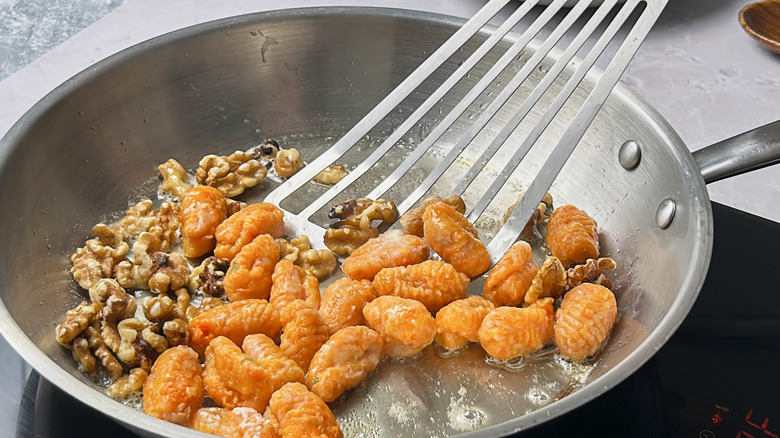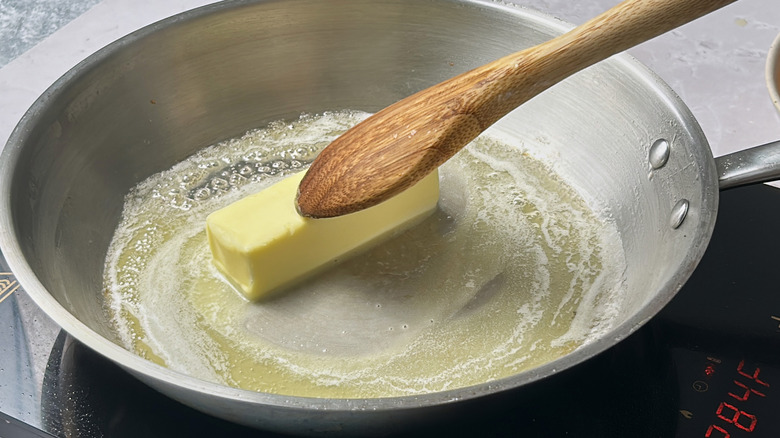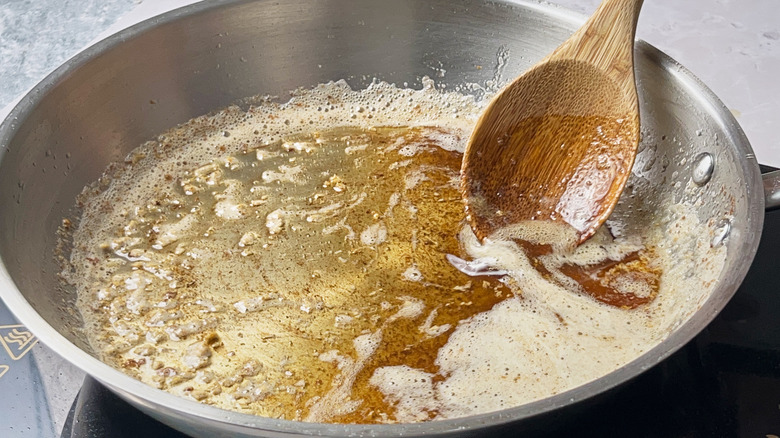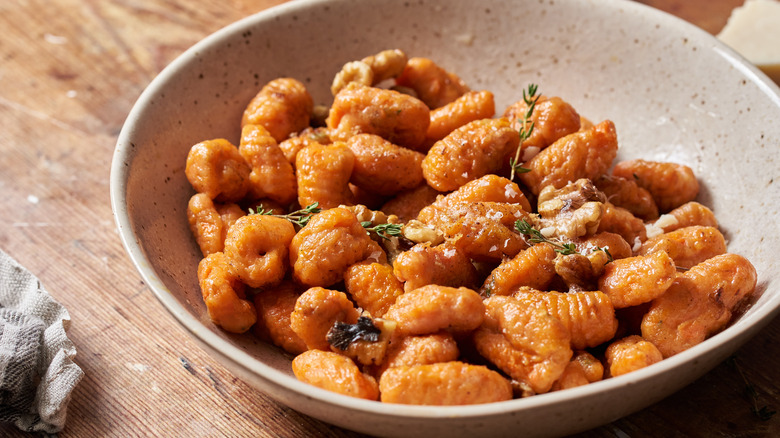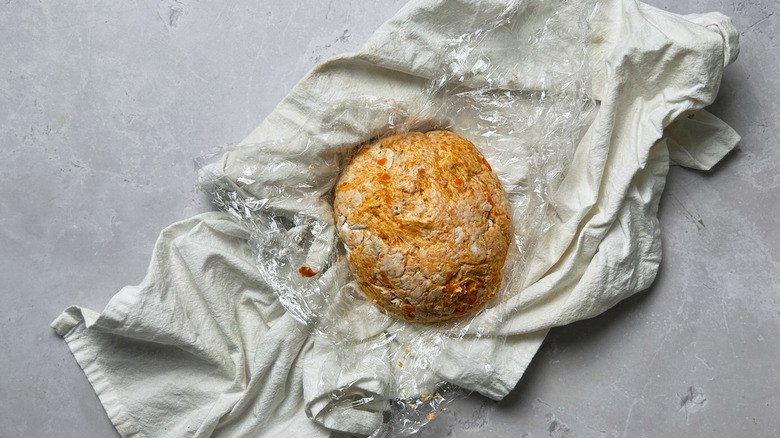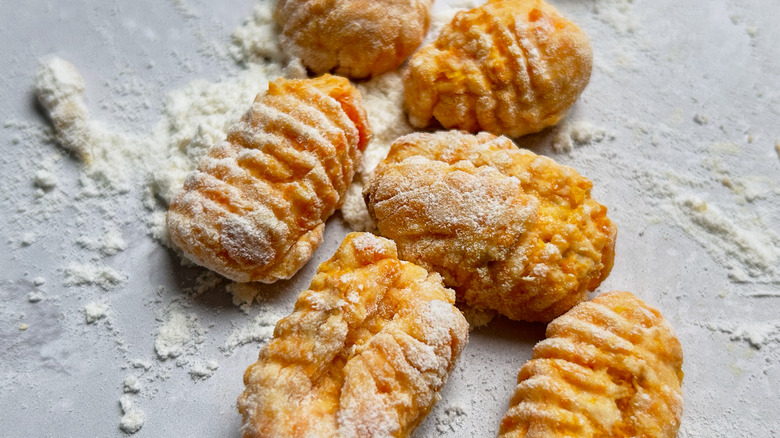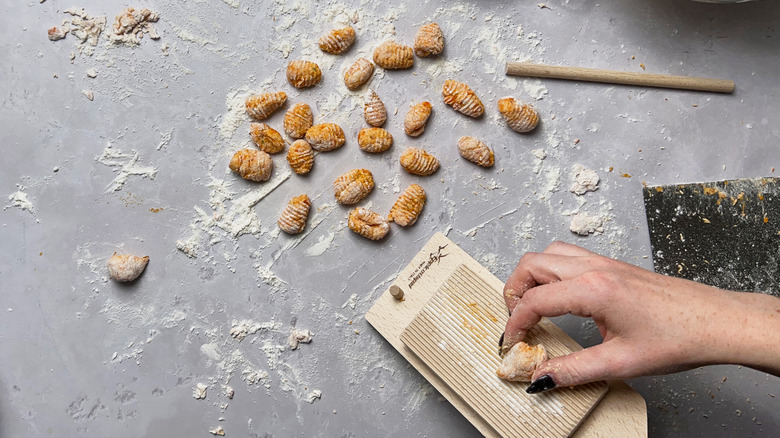Carrot Gnocchi In Walnut Brown Butter Recipe
If you've never made pasta before, gnocchi is a good place to start. Though it is debatable whether gnocchi is a pasta or a dumpling, the technique is most similar to pasta and is a good way to practice more challenging shapes and noodles. The reason gnocchi is considered a dumpling, however, is because it is commonly made with potato mixed into the flour, giving it a pillowy soft texture. Of course, this begs the question: What about ravioli? (Hint: Also a dumpling).
Gnocchi doesn't have to be limited to potatoes. In this recipe written with developer Michelle McGlinn, carrots are used instead, giving the pillowy pockets of flour an earthy taste that pairs well with nutty browned butter. The recipe walks through how to break the carrots down, incorporate them into the flour, and roll them into gnocchi pieces. After that, cooking the gnocchi into a meal is a breeze, especially when paired with a simple but flavorful browned butter sauce. It's all the flavors of fall in a healthy, one-skillet meal.
Gather the ingredients for carrot gnocchi in walnut brown butter
Most importantly, you'll want to grab some clean, healthy carrots. You'll want roughly 3 cups, chopped, which will be about three large carrots or four to five thin carrots. Whether you peel or not is up to you, but if you don't peel, your carrots will need to be cleaned thoroughly before using and the skin might interfere with the texture.
From there, you'll just need flour, freshly grated Parmesan, an egg, garlic, salt, butter, walnuts, and pecorino Romano cheese. We recommend all-purpose flour for ease of use, but you can also experiment with 00 if you have it on hand.
Step 1: Boil the carrots
Add carrots to a saucepan and cover with water. Boil until fork-tender, about 20 minutes.
Step 2: Mash the softened carrots
Drain carrots, place into a large bowl, and mash into a paste using a potato masher.
Step 3: Make the dough
Add the flour, parmesan, egg, 1 clove grated garlic, thyme, and 1 teaspoon salt to the carrots. Combine until a dough ball forms.
Step 4: Gently knead
Transfer the dough to a floured surface and knead gently until firm and workable.
Step 5: Make gnocchi ropes
Cut dough into 4 sections. Roll each section into 1-inch ropes.
Step 6: Cut into gnocchi pieces
Slice each rope into ½-inch pieces.
Step 7: Groove the gnocchi
If desired, roll gnocchi on a rigagnocchi, creating grooves in the dumplings.
Step 8: Boil the gnocchi
To cook the gnocchi, bring a large pot of water to boil. Working in batches, cook gnocchi in boiling water until soft, about 1-2 minutes.
Step 9: Saute the gnocchi and walnuts
Melt 1 tablespoon butter in a large skillet. Add drained gnocchi and walnuts and cook until both are browned, about 4-5 minutes.
Step 10: Add the butter
Remove the gnocchi and walnuts from the skillet. Add the remaining 7 tablespoons butter.
Step 11: Brown the butter
Cook butter over medium heat until browned, stirring often, about 5-10 minutes. Add the remaining grated garlic and salt, and stir to combine.
Step 12: Serve
Pour browned butter over gnocchi. To serve, top with grated pecorino Romano.
Can I store unused gnocchi dough?
Once you get the hang of it, gnocchi is fast and easy to make and shape, even on a rigagnocchi. However, even the most efficient chefs will be cutting and shaping for a while for a four-serving recipe. If your hands grow tired and you can't bear to roll one more tiny carrot-pillow down the gnocchi board, don't worry — the dough can be stored for later. Unfortunately, the dough doesn't last long, so you will have to make the rest of the gnocchi within a week. To store the dough, wrap tightly in plastic wrap and store in the refrigerator. Bring to room temperature before rolling the remaining dough to allow the gluten to rest. You can also store shaped — but not cooked — gnocchi on a floured sheet tray.
The cooked gnocchi is much easier to store and reuse. To store gnocchi for future recipes, boil the gnocchi, then store in the refrigerator or freezer until ready to use. The cooked gnocchi will last for about a week in the refrigerator (or until it discolors) and up to a month in the freezer. To reheat, saute the gnocchi in butter until crispy and golden brown.
Why is my carrot gnocchi sticky?
Making gnocchi is tricky and, like pasta, requires some intuition and testing. Carrot gnocchi differs slightly from potato gnocchi because carrots aren't as starchy, and thus, don't hold together as easily without flour. Unfortunately, with gnocchi, too much flour means a dense and chewy dumpling. To strike a perfect balance with carrot gnocchi, combine the ingredients until the mixture is doughy and tacky, but not sticky. If the gnocchi dough is sticky, more flour is required. Sprinkle the flour into the dough in increments to avoid over-flouring.
If the gnocchi is sticking to the rigagnocchi, flour is still the culprit, but this time needs to be used on the wood itself. Generously flour the rigagnocchi, brush off the excess, and spread flour at the base of the board. Roll the gnocchi, flicking quickly with your thumb, and let it drop into the flour. This avoids flour mixing into your dough while keeping the gnocchi from sticking. It may take some practice to find the perfect amount of flour; if you're having trouble, try rolling smaller gnocchi pieces.
Can I make gnocchi without a rigagnocchi?
Gnocchi is traditionally made with a board called a rigagnocchi to give gnocchi its distinct shape. Gnocchi is meant to be a small oval shape with grooves on one side and an indent on the other, made from rolling the gnocchi down the board and over your thumb. The grooves and indent are designed to pick up sauces, especially thick, traditional tomato gravies. This is best achieved using a rigagnocchi, which is a small, flat, grooved board that the doughy pieces can roll off into perfect shape.
The same effect can be achieved using a fork, but with a smaller surface area will require deft fingers. In a pinch, use the longest-pronged fork you have, or consider slicing the gnocchi and leaving them as plain squares. While plain, grooveless gnocchi might not hold sauce like its indented version, it will be just as tasty and much faster to create in large batches.
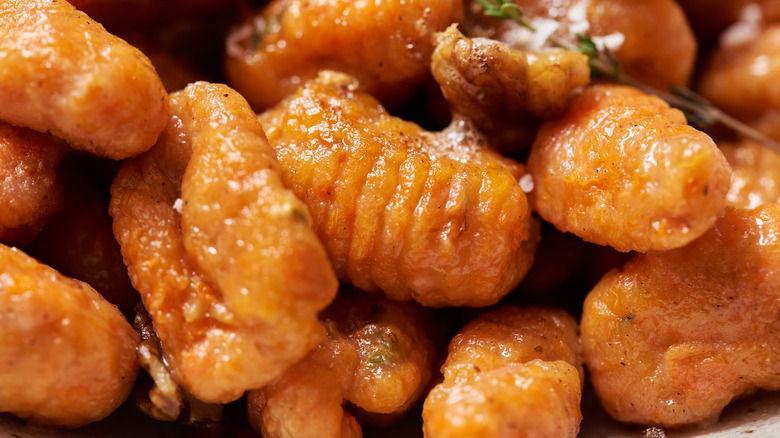
- 3 cups chopped carrots (about 3 whole carrots)
- 3 cups all-purpose flour, plus more for dusting
- ½ cup grated parmesan
- 1 egg
- 2 cloves grated garlic, divided
- 1 tablespoon fresh thyme leaves
- 2 teaspoons salt, divided
- 8 tablespoons (1 stick) butter, divided
- ½ cup walnuts
- ½ cup grated Romano cheese
- Add carrots to a saucepan and cover with water. Boil until fork-tender, about 20 minutes.
- Drain carrots, place into a large bowl, and mash into a paste using a potato masher.
- Add the flour, parmesan, egg, 1 clove grated garlic, thyme, and 1 teaspoon salt to the carrots. Combine until a dough ball forms.
- Transfer the dough to a floured surface and knead gently until firm and workable.
- Cut dough into 4 sections. Roll each section into 1-inch ropes.
- Slice each rope into 1/2-inch pieces.
- If desired, roll gnocchi on a rigagnocchi, creating grooves in the dumplings.
- To cook the gnocchi, bring a large pot of water to boil. Working in batches, cook gnocchi in boiling water until soft, about 1-2 minutes.
- Melt 1 tablespoon butter in a large skillet. Add drained gnocchi and walnuts and cook until both are browned, about 4-5 minutes.
- Remove the gnocchi and walnuts from the skillet. Add the remaining 7 tablespoons butter.
- Cook butter over medium heat until browned, stirring often, about 5-10 minutes. Add the remaining grated garlic and salt, and stir to combine.
- Pour browned butter over gnocchi. To serve, top with grated Romano.
| Calories per Serving | 817 |
| Total Fat | 44.0 g |
| Saturated Fat | 21.3 g |
| Trans Fat | 0.0 g |
| Cholesterol | 130.9 mg |
| Total Carbohydrates | 79.9 g |
| Dietary Fiber | 4.9 g |
| Total Sugars | 3.0 g |
| Sodium | 536.8 mg |
| Protein | 26.0 g |
